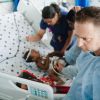Sending the message: you’re not on your own
Thirty years after the Chernobyl nuclear disaster many German initiatives are still helping to deal with the consequences.

Wild horses are grazing in the shadow of Reactor 4, sometimes bison as well. But the idyllic setting is deceptive: 30 years after the disaster at the Chernobyl nuclear power plant, Geiger counters still detect radioactivity there. All those living within a 30-kilometre radius of the power station had to leave their homes in April 1986. The sarcophagus that was hastily erected over the ruins back then is crumbling. A new protective mantle is being built to stabilise the structure. The G7 countries have undertaken to complete its construction by 2017 with the Chernobyl Shelter Project. It proved possible to secure the required funding at an extraordinary donor conference in April 2015, which was chaired by Germany. Together with the European Union, the G7 countries are providing 165 million euros. The European Bank for Reconstruction and Development (EBRD) is contributing an additional 350 million and third countries have pledged 48 million.
Dealing with the long-term effects in technical terms is one thing; providing support to the people affected is another. In the immediate aftermath of the disaster, many associations were set up in Germany that are still active today. One of the first, Heim-statt Tschernobyl, was founded in 1991 by Dietrich and Irmgard von Bodelschwingh. An encounter with radiation victims at a hospital in Belarus in 1990 greatly upset the couple: “We stood at the beds of children contaminated by radiation and had an inkling of how sick they were. We knew that there are plenty of initiatives back home that bring children to Germany to convalesce. But we also knew the problems these children faced when they returned to their contaminated homeland.”
They organised a resettlement programme under which German helpers and affected families join forces to build houses. Each summer, they meet for three weeks in Belarus to build new accommodation in the non-contaminated north of the country. The joint project, in which some 1,500 volunteers have participated so far, has resulted in many friendships.
Heim-statt Tschernobyl’s engagement is typical of that of many other initiatives. For example, some 6,500 German doctors, medical students and supporting members are campaigning for a peaceful world free of nuclear technology through the organisation International Physicians for the Prevention of Nuclear War (IPPNW). Even before the Chernobyl disaster, back in 1985, the IPPNW was awarded the Nobel Peace Prize for its work in this area.
Another visible sign of German engagement is the Nadeshda Health and Education Centre, which was opened near Minsk in 1994. The joint Belarusian-German project looks after young people affected by the long-term consequences of the disaster. Those in charge of the project are seeking to promote a sustainable lifestyle and renewable energy. Its supporters include the Frankfurt-based association Leben nach Tschernobyl. To mark the 30th anniversary of the nuclear accident, it is helping to fund the construction of a solar system for the centre in order to set a “pan-European example for the energy transition“. ▪

